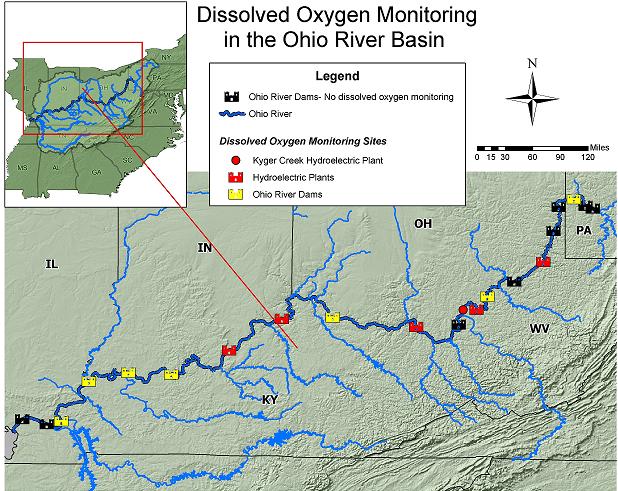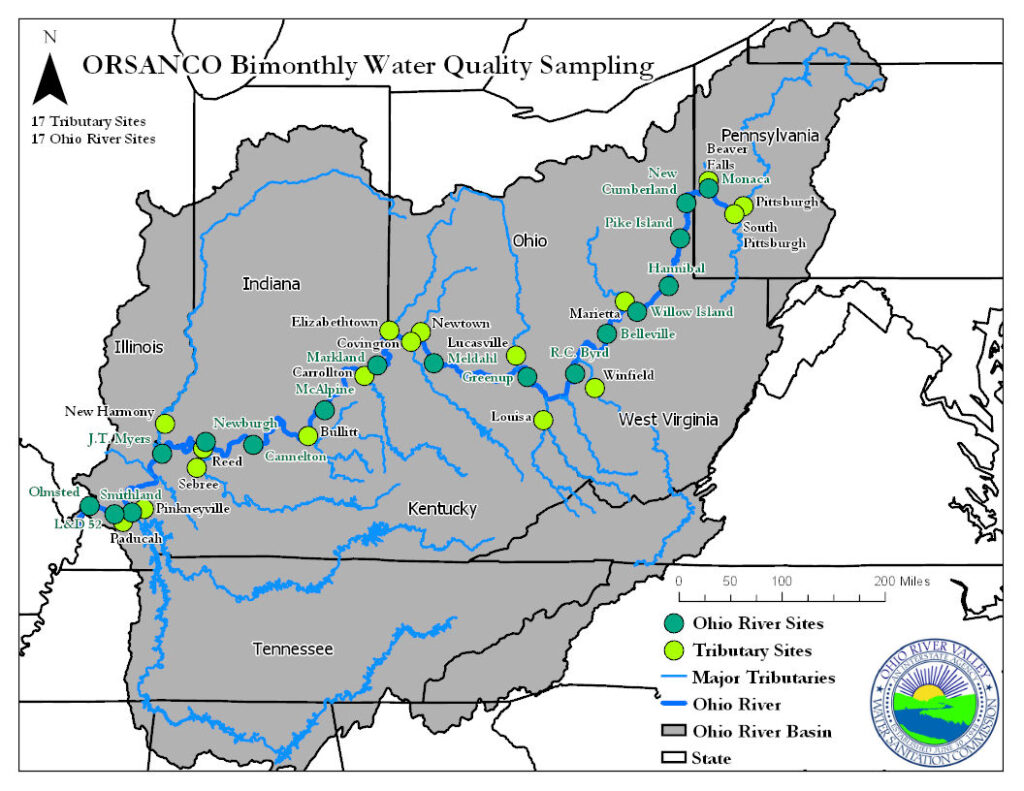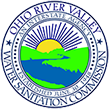During the months of May through October, ORSANCO interrogates thirteen stations for dissolved oxygen (D.O.) and temperature data once per day, Monday through Friday, for the previous 24-hour period. This data is compiled in-house to produce a report showing the minimum, maximum and average of the acquired D.O. and temperature readings. ORSANCO has also deployed Hydrolabs at three locations: Newburgh, J.T. Myers, and Smithland. This daily data is used in place of the Corps of Engineers data. ORSANCO’s water quality criteria for the protection of warm water aquatic life habitat are:
- The minimum D.O. concentration shall not be less than 4.0 mg/L at any time.
- Average D.O. concentration shall be at least 5.0 mg/L for each calendar day.
- During the April 15 – June 15 spawning season, a minimum concentration of 5.0 mg/L shall be maintained at all times.
For more information on Dissolved Oxygen data, please contact Stacey Cochran.

Bimonthly Water Quality Sampling
Dissolved Oxygen is a parameter of the Bimonthly Water Quality Sampling Program, which is ORSANCO’s long-term water quality monitoring program for the Ohio River. Parameters include ammonia nitrogen, biochemical oxygen demand, bromide, chloride, dissolved organic carbon, dissolved oxygen, total hardness, nitrate/nitrite nitrogen, orthophosphate, pH, specific conductivity, sulfate, temperature, total dissolved solids, total kjeldahl nitrogen, total nitrogen, total organic carbon, phenols, total phosphorus, total suspended solids, and turbidity.
Bimonthly samples are collected from 34 locations: 17 on the Ohio River main stem, and 17 on major tributaries:

In addition to the above parameters collected bimonthly at 34 locations, trace metals are analyzed concurrently at the 17 Ohio River locations. ORSANCO adopted criteria for several inorganic toxicants to protect human health and against chronic (long-term) and acute (short-term) toxicity to aquatic life.
All samples are analyzed at a central laboratory to maintain Quality Assurance/Quality Control protocols. Cyanide analyses are only conducted at eight of the upper-river sites during the months of January, March, and November. During warmer months, cyanide quickly decomposes into ammonia and carbon dioxide and is rarely detected, and as such, is only analyzed during winter months.
ORSANCO submitted bimonthly data from 1975 through the most current analyses to USEPA’s Water Quality Exchange (WQX), and the National Water Quality Monitoring Council’s Water Quality Portal. You may also contact Ryan Argo for more information.
Dissolved Oxygen Data
| 2024 | Download |
| 2023 | Download |
| 2022 | Download |
| 2021 | Download |
| 2020 | Download |
| 2019 | Download |
| 2018 | Download |
| 2017 | Download |
| 2016 | Download |
| 2015 | Download |
| 2014 | Download |
| 2013 | Download |
| 2012 | Download |
| 2011 | Download |
| 2010 | Download |
| 2009 | Download |
| 2008 | Download |
| 2007 | Download |
| 2006 | Download |
| 2005 | Download |
| 2004 | Download |
| 2003 | Download |
| 2002 | Download |
| 2001 | Download |
| 2000 | Download |
| 1999 | Download |
| 1998 | Download |
| All Bimonthly Monitoring Water Quality Parameters Data 2000-2021 | Download |

